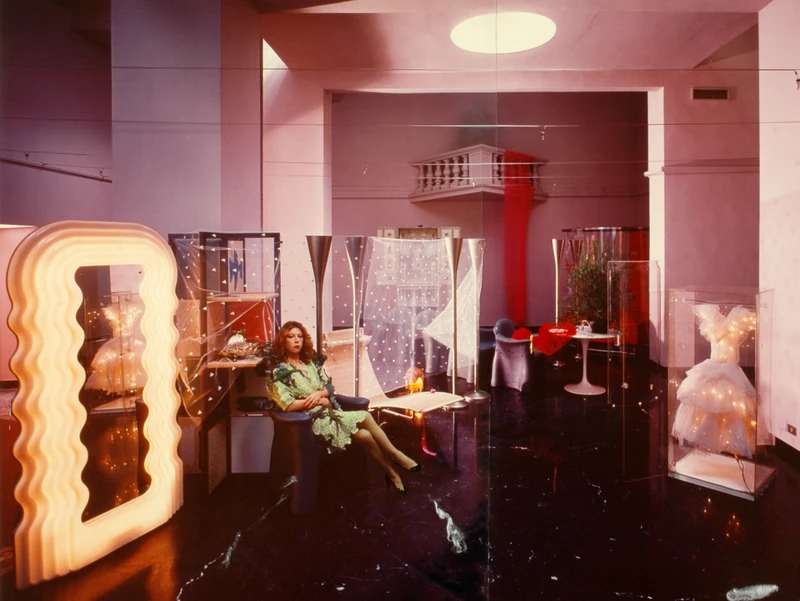Cinzia says…
5 Nov 2022-12 Feb 2023
PV 4 Nov 2022, 7-9pm


Cinzia says… is the first major retrospective of artist and fashion designer Cinzia Ruggeri (1942–2019), a unique figure of Italian postmodernism who moved freely across artistic disciplines. Her life and versatile practice were driven by a desire to redefine the form and function of elements of everyday life. From clothing and accessories to furniture and lighting – and in sculptural installations often including these objects – Ruggeri created worlds that were continually imaginative, provocative, elegant and unpredictable. Consistently boundary-pushing, her objects sat somewhere between performance and architecture, always questioning how the body might inhabit space.
A seminal but overlooked figure within Italian postmodern art and design, the exhibition offers the widest and most complete overview of Ruggeri’s career to date, thanks to in-depth research conducted by MACRO (Museum of Contemporary Art of Rome) in collaboration with the Archivio Cinzia Ruggeri in Milan. Ruggeri shared an affinity with the Radical Design scene in Milan in the 1970s, and was associated with the city’s Studio Alchimia and Memphis groups. She founded her own fashion line in 1977, and immediately became known for her use of architecture and geometry like the ziggurat and representations of the shape of Italy. Playful components of the natural world like eggs, dogs, pigs, and flowers all became recurring motifs in her work. She was one of the first designers to experiment with electronic technologies, incorporating liquid crystals, LED lights and kinetic movement into her garments and artworks.
The exhibition will feature a wide selection of garments from Ruggeri’s Fluxus, Cinzia Ruggeri and Bloom collections, newly restored and presented for the first time since their runway debuts in the 1970s and 1980s. Selections of her accessories – bags, shoes, gloves, and ties – will be presented, including her famous Slap-glove bag (1983), which fuses a glove and a clutch, and a pair of boots shaped in the outline of Italy (Italy boots, 1986). Among the clothing will be Ruggeri’s famed Bed Dress (1986), a gown with matching pillow headpiece that has since served as inspiration for both Viktor & Rolf (A/W 2005–06) and Maison Martin Margiela (S/S 2015). Displayed alongside the clothes will also be Ruggeri’s mosaics, sculptures, sofas, jewellery and glassware, as well as footage of her theatrical catwalk shows and music videos for which she designed clothes. Much of her work has a sense of familiarity, such is the extent to which her designs have been borrowed from over the decades.
A major highlight of the show will be the reconstruction of la règle du jeu?, the artist’s last exhibition, presented a few months prior to her death in 2019. Using Jean Renoir’s 1939 film of the same title (The Rules of the Game) as a pretext, Ruggeri’s sculptural installation becomes a kind of cabinet of curiosities of autobiographical puzzles and formal play that is indicative of the rest of her work.
Ruggeri’s impact on the world of pop music and defining a particular postmodern look is implied in the title Cinzia says… This title is a play on the first verse of the lyrics of the song Elettrochoc by renowned Italian pop band Matia Bazar, with whom Ruggeri frequently collaborated. During her lifetime she also worked and collaborated with Brian Eno, Occhiomagico, Alessandro Mendini, Casa Vogue, Maison Carven, and Studio Alchimia. One of her celebrated ziggurat dresses, Homage à Lévi-Strauss (1983), is in the collection of the V&A Museum.
Ruggeri’s importance as a polymath, and her links to Milan, a city known for its design and culture, have led to her being seen as something of a cult figure. In 1960, aged just 17, she had her first solo exhibition at Galleria del Prisma in Milan, which was accompanied by a text by novelist and poet Dino Buzzati. Overwhelmed by the press attention it received, she gave up art to study design, and worked in Paris at fashion house Carven before returning to Milan in 1970. After she closed her fashion lines at the end of the 1980s, she moved towards interior design before returning to art towards the end of her life. Ruggeri’s fluidity between disciplines will be highlighted in the exhibition’s presentation at the CCA. Her work continues to be a significant example of how artists can navigate outside of the confines of medium-specificity so often forced upon them. Both the familiar and idiosyncratic nature of her work are testament to how influential and forward-thinking her designs were for her time, and how late relatively to her male peers her recognition has been in coming.
The exhibition has been curated by Luca Lo Pinto, Artistic Director, MACRO, and produced in partnership with the CCA. The exhibition runs at MACRO from 14 April – 28 August 2022.